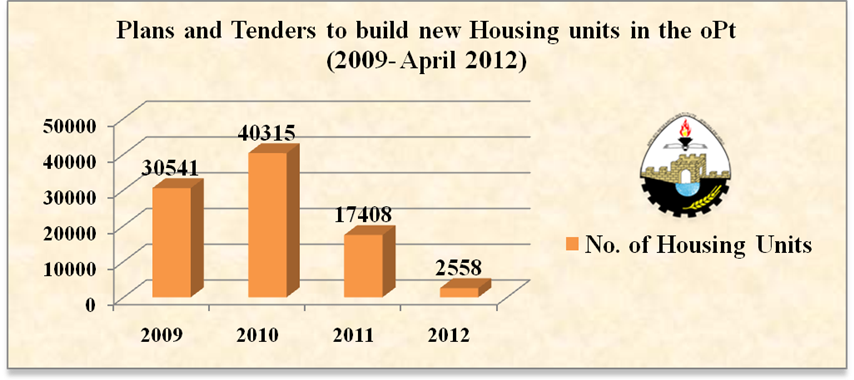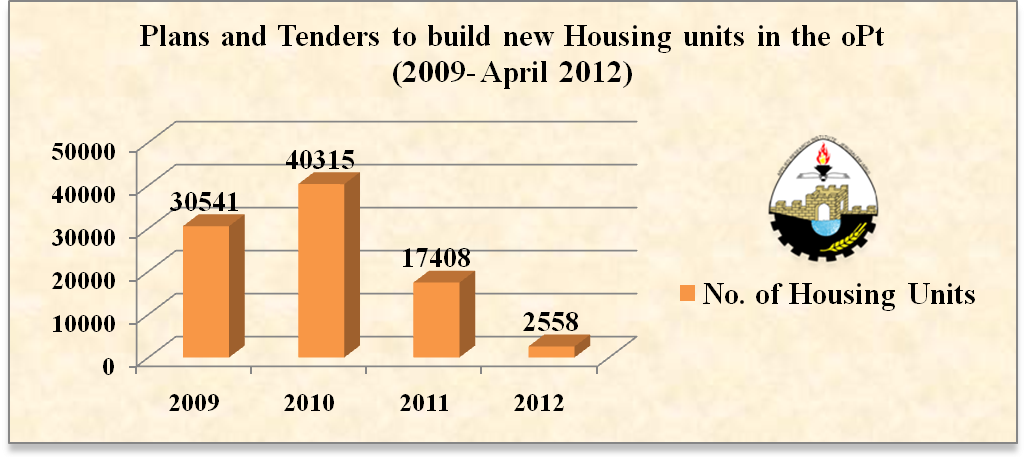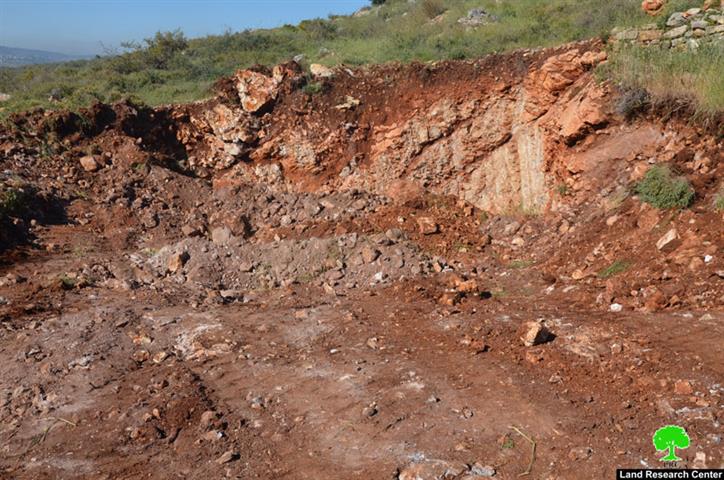‘The principle that guided me is to strengthen Jewish communities in Judea and Samaria’. PM Benjamin Netanyahu remarks for his new colonial projects in the oPt, cabinet meeting- Jerusalem, April 4, 2012.
Three years and two weeks since Netanyahu’s right wing Israeli government took office in March 31, 2009, where he launched methodic colonial plans that reflected his scope of ideology and showed to which extent he and Israel for that matter are willing to concede in the occupied territory to the Palestinians, where he is moving rapidly toward imposing new geographical reality that serve his colonial and expansionist orientations which would be achieved through spreading the settlements and their outpost throughout the Palestinian Territory and eliminating any chance to reach a just and durable peace agreement with the Palestinians based on Two State solutions on the 1967 borders.
Since the beginning of the year 2009 until the date of writing this report, the Israeli authorities issued a plans and tenders to build new
90,822 housing units in the West Bank settlements including East Jerusalem.
See Chart 1
Chart 1: Plans and Tenders to build new housing units in Israeli Settlements in the oPt
During the last two weeks, tremendous colonial activities took place on the ground in many parts in the oPt, with the direct support and guidance from Benjamin Netanyahu and his government:
1- New Settlement ….. Kidmat Zion
On April 2, 2012, the Israeli daily newspaper ‘Haaretz’ revealed on a new Israeli plan to build a new Illegal settlement adjacent to the Israeli Segregation Wall in Abu Dis town east of the city of Jerusalem. The plan includes the building of 200 housing units in the site which is located at the eastern part of the Wall inside the isolated lands between Abu Dis and Jabal Al-Mukabber Jerusalemite neighborhood.

Kidmat Zion
The story of Kidmat Zion started back in June 7, 2000, when a group of extremist Israeli Knesset members along with Yeshiva students erected a barbed wire fence and planed olive trees seedlings on 15 dunums out of 64 dunums owned by Palestinians from Abu Dis. It is worth mentioning that on May 22, 2000, the Israeli Ministry of Housing and Construction specified the 64 dunums (confiscated illegally by what is so-called the Custodian Absentee Property) to build Kidmat Zion settlement with more than 200 housing units. Photo 1 shows the site of the proposed settlement of Kidmat Zion captured by ARIJ field workers in 2008:

2- Netanyahu Era: 3 Illegal Outposts plus 3 Illegal Settlements = Six legal Settlements !!!
The Israeli PM, Netanyahu, and on April 17, 2012, approved a plans to legalize three illegal settlements in the West Bank, after he get recommendations approved by the Defense Minister Ehud Barak to formalize the status of Bruchin, Rechalim and Sensana settlements in the West Bank.
According to Netanyahu, Bruchin settlement is proposed to be part of Eli Zahav (2 km between them) while Rechalim settlement is proposed to be part of Kfar Taphuh settlement (1.5 km) and Sensana settlement to be part of Eshkelot settlement (2.5 km). See table 1
|
Table 1: Israeli settlements set to be legalized by the Isrageli Government
|
|
Settlement. Name
|
Location
|
Date of Est.
|
Population 2009
|
Area- Dunums
|
|
Rechalim
|
Salfit
|
1991
|
185
|
519
|
|
Sensana
|
Hebron
|
1999
|
225
|
234
|
|
Bruchin
|
Salfit
|
1999
|
470
|
328
|
|
Eli Zahav
|
Salfit
|
1982
|
851
|
352
|
|
Kfar Tepouah
|
Salfit
|
1978
|
919
|
614
|
|
Ashkelot
|
Hebron
|
1982
|
518
|
157
|
|
Source: Geo Informatics Department, ARIJ- 2012
|
As a matter of fact, Netanyahu’s decision to legalize the three illegal settlements of Bruchin, Rechalim and Sensana, to be administratively annexing them to Eli Zahav, Kfar Tepouah and Ashkelot, did not com randomly, but affected by his expansionist and colonial desires, where he prefers, and in a stroke from his pen, to legalize three illegal settlements instead of dismantling them, where for Netanyahu it is an innovative solution for the interest of the Israeli settlers while for the Palestinians constitute a creation of a new additional three obstacles to peace legalized by the occupation beside the catastrophic geographical consequences that would take place as a result of this decision. See Maps 1, 2 & 3

Map 2: Rechalim and Kfar Taphuh settlements

Map 3: Sensana and Eshkolot settlements
3- Legalization of Ulpana Outpost- Ramallah
Netanyahu, and in a cabinet meeting held on April 4, 2012, announced that his government would not evacuate the illegal outpost of Ulpana northeast of the settlement of Beit Il1 despite the fact that this outpost classified illegal according to the Israeli measures, where it was built on private Palestinian lands. Moreover, the Israeli PM asked what is called the ‘Attorney General of the State of Israel’, Yehuda Weinstein, to find a solution that will end with the legalization of the illegal outpost to prevent the demolition of about 30 housing units in the outpost.
Ulpana is an illegal Israeli outpost established in the year 1995 outside the Israeli boundaries of the illegal settlement of Beit Il. The outpost located about 200 meters east of Beit Il settlement on a hilltop called Jabal Artis owned by Palestinian residents from Ramallah Governorate. On the year 2002, herd of Israeli settlers along with their families started to expand the outpost where until now there are more than 30 housing units (built by cement and stone) with other facilities.According to ‘Sasson report’2, Ulpana outpost was classified illegal and must be dismantled instead of being supported by the Israeli authorities, where according to the aforementioned report the outpost received 4.5 million NIS from the Israeli Ministry of Housing and Construction. Ulpana outpost set for the demolition by April 2012. See Map 4

Map 4: Location of Ulpana outpost
4- Plans to build 812 new housing units in Har Homa & Pisgat Ze’v settlements
On April 4, 2012, the ‘Israeli Ministry of Housing and Construction’, published five tenders to build 872 new housing units in two Israeli settlements. The tenders included 632 housing units in the illegal Israeli settlements of Har Homa3 north of Bethlehem Governorate and south of Jerusalem city,while the remaining units (180 units) to be built in Pisgat Ze’ev4 settlement north of the city of Jerusalem. According to the so called ‘Israel Land Authority’, the 632 housing units in Har Homa settlement is a third level of building a new neighborhood in the settlement named ‘Har Homa C’, in an addition to the sale of 4 dunums inside the settlement for commercial purposes.
5- New Outpost in Mount of Olives – Jerusalem
On April 3, 2012, Fakhri Abu Diab, the head of the ‘Committee of Defending Silwan Lands and Properties’ revealed about a new illegal outpost installed nearby the ‘Seven Arches’ hotel in the Mount of Olives (500 meters away from the Old City) and overlooking Al-Aqsa Mosque in the eastern part of the occupied city of Jerusalem. Mr. Abu Diab indicated that the Israeli security forces were residing in the site before they installed additional mobile homes and offices in one of the most sensitive locations in the city of Jerusalem. See Map 5:
Expansion of a Settlement and an outpost in Yatta Town-Hebron
On April 5, 2012, Mr. Rateb Al-Jabbour, the coordinator of the Popular Committee against the Wall and Settlements in Yatta town south of Hebron Governorate revealed that the Israeli settlers residing in illegal outpost ‘Avigal’, located east of Yatta town, are working during the night to raze more Palestinian lands surrounding the outpost to expand it on the expense of the Palestinian neighboring lands. The targeted lands are owned by local families of ‘Al-Jabareen, Mohammad and Abu-‘Aram’. Furthermore and not far away from Avigal outpost, Israeli settlers of the nearby illegal settlement ‘Ma’on’5 located to the southeast of Yatta town are working rapidly to expand their illegal settlement towards the east. See Map 6

It should be noted that on October 2011, the Israeli PM Benyamin Netanyahu spearheaded a special committee to explore ways to legalize 134 settlements built on private Palestinian lands, a step that contradicts with the Israeli obligations and commitments towards the peace process and the Road Map plan proposed in May 2003 by the USA and the Quartet in which Israel is supposed to freeze all the settlements’ activities in the occupied Palestinian territory and dismantle all of the Illegal outposts erected after March 31, 2001.
Legal & International Status
Netanyahu’s right-wing extremist government is moving unilaterally and intentionally toward imposing facts on the ground where the chances to conclude a just and lasting peace agreement based on two state solution became threatened and is thinning by the day. Accordingly, Netanyahu’s denial of the International legitimacy represented by the United Nation Security Council Resolutions mainly 338 & 242, and it’s deliberately foiling any International-led efforts for the interest of reaching just and durable peace agreement with the Palestinians, shows the real face for the longest Israeli Occupation.
- UNSCR 242, adopted in November 22, 1967: Calls on Israel to withdraw from the all of the Territory it occupied in its aggression on June 5, 1967.
- Also United Nation Security Council Resolution No. 446 of 1979 calls on Israel to rescind its previous measures and to desist from taking any action which would result in changing the legal status and geographical nature and materially affecting the demographic composition of the Arab territories occupied since 1967, including Jerusalem and, in particular, not to transfer parts of its own civilian population into the occupied Arab territories’
- Also UNSCR No. 452 of 1979 ‘calls upon the Government and people of Israel to cease, on an urgent basis, the establishment, construction and planning of settlements in the Arab territories occupied since 1967, including Jerusalem.’
- Moreover ,UNSCR No. 465 of 1980 ‘called upon Israel to stop building in the Israeli settlements in the occupied territories and to dismantle all of the Israeli settlements built in the aforementioned territories since the year 1967, and demanding all of the state parties of the UN not to help Israel in building these Illegal settlements’.
- Furthermore the Forth Geneva Convention of 1949 also states in Article 49 that ‘The occupying power shall not deport or transfer parts of its own population into the territories it occupies.’
- Article 174 Forth Geneva Convention of 1949 also prohibits the ‘extensive destruction and appropriation of property not justified by military necessity and carried out unlawfully and wantonly.’
- Article XXXI of the 1995 Oslo agreement Israelis forbidden from building or planning to any project or settlements or any colonial expansion or any plan that lead to change the status of the West Bank and Gaza Strip. The article provides ‘Neither side shall initiate or take any step that will change the status of the West Bank and the Gaza Strip pending the outcome of the permanent status negotiations’
- In May 2001, the head of the International Red Cross delegation to Israel and the Occupied Territories said that settlements are ‘equal in principle to war crimes’. (Note: ‘The transfer, the installation of population of the occupying power into the occupied territories is considered as an illegal move and qualified as a ‘grave breach.’ It’s a grave breach, formally speaking, but grave breaches are equal in principle to war crimes’, Rene Kosirnik, head of the ICRC delegation to Israel and the OPT, press conference 17 May 2001).
1Beit �Il: Established in 1977, north of the city of Ramallah, over 1,056 dunums of lands. The settlement has a population of 5,600 settlers.
2 Talia Sasson Report: Official Israeli government report prepared by the former head of the State Prosecution Criminal Department, Talia Sasson, and published on March 8, 2005.
3Pisgat Ze�ev: Established in 1985, north of the city of Jerusalem, over 41,882 dunums of lands. The settlement has a population of 20,000 settlers.
4Har Homa: Established in 1997, north of the city of Jerusalem, over 1546 dunums of lands. The settlement has a population of 20,000 settlers.
5 Ma�on: Established in 1980, southeast of Yatta town south of Hebron Governorate, over 683 dunums of lands. The settlement has a population of 417 settlers.



















